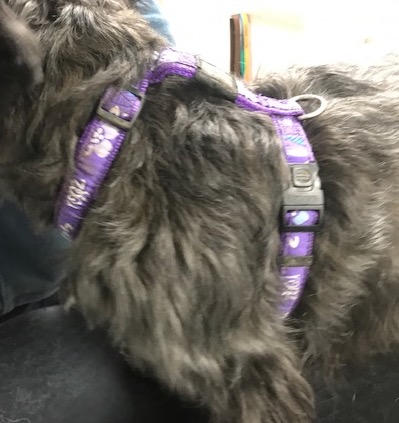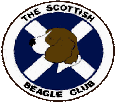|
Should I use a Collar or Harness on my Beagle?
May 2020
By Samantha Goldberg BVSc MRCVS
The law in the UK states that a dog must wear a collar and tag in a public place. This has not changed since it also became compulsory for all dogs over 8 weeks to be microchipped. It is not legal to sell or rehome a dog that is not microchipped.
A dog that wears a harness must still carry a tag whether it is on a collar or attached to the harness.
The question of whether to put a collar or harness on a beagle is frequently asked by new owners. The question that I see a lot is “What type of harness shall I buy for my beagle?”
Before making a decision it is important to understand the following information:
- Beagles are a hunting breed but not a tracking breed. When out being walked they will follow scents and often pull towards interesting smells. This is natural to them and not a personal thing against their owner! The ideal life for a beagle is to have controlled exercise and some off lead time to behave instinctually.
- If your beagle pulls changing to a harness will not stop the pulling. You need to train your dog to walk correctly on a lead and it is entirely possible to teach a beagle not to pull whilst wearing a collar. For a beagle who does pull a lot a head collar type lead such as a Gencol or Gentle leader can be used. Initially the beagle may try and rub this off but with encouragement and rewards for walking properly (a small treat and verbal encouragement) your beagle will walk well.
- If you have a beagle that lunges towards other dogs, spend some time teaching your beagle to sit for a small treat, then teach them to sit whenever another dog appoaches. This is called displacement behaviour and replaces and adverse behaviour for an acceptable one. It may take some time, particularly if they are a rescue, but with work your walks will become more enjoyable. Once your dog has been trained a collar can be used with the halter as a back up if required. Halter type devices work by turning the dog’s head back towards you as they attempt to pull. Thus they stop pulling as facing the wrong way.
There is a lot of discussion particularly on social media about using harnesses instead of collars to walk dogs. All sorts of reasons are given.
Some facts to note:
- Harnesses were originally developed for working dogs in different roles. Thus tracking dogs such as Bloodhounds looking for missing people or fallen deer need freedom to move as they follow a scent. A harness is easier for them to move without being distracted by the handler but the handler still has an attachment to the dog. You will see videos of people tracking missing people with a long line attached. These dogs are not walking beside a road. Dogs such as Siberian Huskies and Alaskan Malamutes pull sleds and harnesses allow allow them to exert more power and pull more weight or free sled caught in ice. Thus expeditions to the North Pole could take huge amounts of food and equipment with light weight dogs pulling the sleds. These dogs develop tremendous power with their front assembly and can pull far more than their body weight. These harnesses are very specific and do not impede movement on the shoulder joints.
- Many fashion harnesses impede natural movement of the shoulder joints. This has long term detrimental affects on the dog and may result in problems later on, apart from being very uncomfortable. The dog may appear to be better behaved purely because the harness is causing pain. This may also be why some dogs duck out of their harnesses if they can when offered a walk. There are so called no pull harnesses. Some of these work by exerting pressure on the nerve and muscle supply around the shoulder and axilla (armpit) and thus work by stopping normal movement - avoiding these is a must for the dog’s enjoyment for a walk.
You will note both these reasons - freedom to move and exert more power - do not make a harness easier to walk your beagle!
Reasons given on social media to use a harness:
- It will stop your dog pulling - FALSE - see above!
- It will make your dog behave better - FALSE - see above!
- It will stop your dog hurting their neck.
- They are safer.
In some VERY SPECIFIC cases reduction in pain may be true. Dogs with Intervertebral Disc Disease (IVDD) using a harness is essential to aid their recovery. The harness is a body wrapping style and used to help lift them onto their hind legs during recovery. A dog who has had neck surgery may be better on a harness long term but it will be less controlled.
Beagles who have had Steroid Responsive Meningitis (SRM) during the recovery phase will be more comfortable on a harness. SRM produces neck and head pain so this makes sense. however once recovered they are the same as any other beagles.
As discussed above harnesses can actually be more detrimental to comfort than a traditional collar.
Any harness that is worn should consist of a collar part and nothing around the shoulders and a secure band around the rib cage. Avoid the big heavy harnesses which wrap around the front of the dog as these can prevent the shoulder joint from moving normally. When you fit a harness make sure it has a safe collar part which the dog cannot escape from and that it is tight enough elsewhere to avoid slipping out. Once you have fitted it on you dog stretch out their forelegs in it and make sure it doesn’t impinge on the dogs ability to walk. If you need to use one the ideal type will look like two collars in parallel with a connection between the dog’s front legs and one at the top.
 
The photos show two of my patients modelling their harnesses. You can see their appears to be no restriction on the shoulder joints and leg movement. The collar part is adjustable and secure and the caudal loop is too. However read the article at the end.
Safety - there are many instances when dogs have slipped out of harnesses and escaped, some with tragic consequences. Anyone using a harness MUST ensure it fits snugly and there is no chance of the dog getting out of it. This also applies to collars. A collar should be secure and no risk of breaking open. The general rule is that no more than two fingers can be fitted between the dogs and collar. A wider collar is generally more comfortable so at least 2cm in width. Check the safety record before buying and make sure it is strong enough. If you have a dog who is nervous of going to the veterinary surgery it is essential they wear a collar. You will have more control in this situation and find it easier to reassure your dog as you will have a closer connection. This also follows if you have a dog who is aggressive as it is very difficult for a vet to examine a dog on a harness where the dog is unable to be restrained.
Any beagle who is dog or people reactive will be more inclined to lunge if they wear a harness. If you have a dog who is like this, maybe a rescue, teach them to walk quietly on a collar and sit down in a stressful situation and be rewarded with a treat.
The article below looked at the extension of the shoulder joint in restrictive and non restrictive harnesses and found both reduced the amount of extension of this joint and in fact harnesses promoted as non restrictive appeared to be worse. This is a peer reviewed scientific study published in the Veterinary Record a UK based journal and really suggests that the use of harnesses should be viewed with caution in normal dogs with no medical condition. The Canine Sports website is well worth reading as there are several articles on there from scientific studies.
https://www.caninesports.com/uploads/1/5/3/1/15319800/lafuente_effects_of_harnesses.pdf
|
